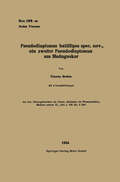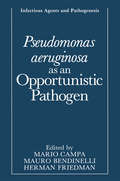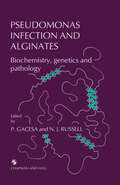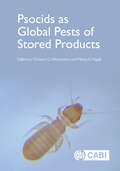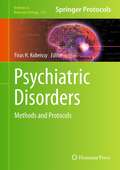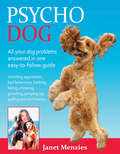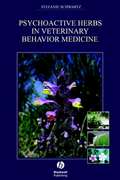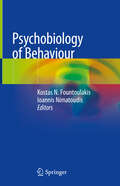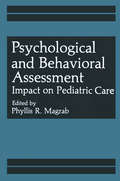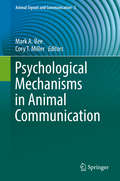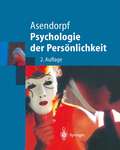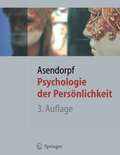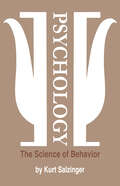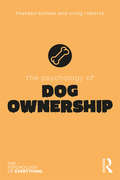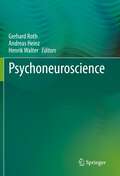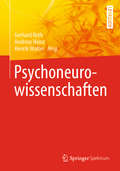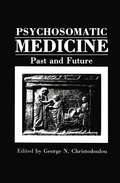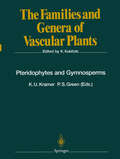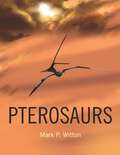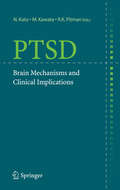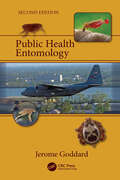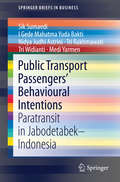- Table View
- List View
Pseudodiaptomus batillipes spec. nov., ein zweiter Pseudodiaptomus aus Madagaskar (Sitzungsberichte der Österreichischen Akademie der Wissenschaften)
by Vincenz BrehmPseudomonas aeruginosa as an Opportunistic Pathogen (Infectious Agents and Pathogenesis)
by Mario Campa Mauro Bendinelli Herman FriedmanAssembling the latest research by an international group of contributors, this volume covers the epidemiology, pathogenesis, clinical features, and control measures of this elusive microorganism. It will provide a deeper understanding of the pathogen to physicians and surgeons caring for patients infected, or at risk of becoming infected, with Pseudomonas Aeruginosa.
Pseudomonas Infection and Alginates: Biochemistry, genetics and pathology
by N. J. Russell P. GacesaThe concept of this book arose out of an international workshop, which we organized and held at the University of Wales Conference Centre at Gregynog. The workshop was the first occasion on which researchers from all the different disciplines concerned with the extracellular virulence factors of mucoid strains of Pseudomonas aeruginosa in relation to cystic fibrosis (CF) had met to discuss this multifaceted problem. It was deemed a particularly timely moment to gather together experts for the exchange of facts, ideas and hypotheses. No formal abstracts were presented and no proceedings were published. But during the succeed ing months the organizers were persuaded by a number of participants that a wider audience should benefit from what had proved to be such a fruitful cross-fertilization of expertise. Thus we moved from being workshop organizers to book editors, sure in the knowledge that at least we had a willing and enthusiastic set of contributors! It should be stressed, however, that this book is not a transcript of that workshop. Not all those participants are authors, and some new names have been added. Instead we have focused on alginate as an extracellular virulence factor of P. aeruginosa in CF pulmonary infections. Recent advances in the biochemistry and molecular genetics of alginate bio synthesis, as well as in our understanding of the basic defect in CF and isolation of the gene, mean that the book is even more timely than when first planned.
Psocids as Global Pests of Stored Products
by Edited by Christos G. Athanassiou, Manoj K. NayakPsocids have become widespread pests of stored products during the last two decades, yet little was known about their biology and management until this change in their pest status. The aim of this book is to synthesize current information on biology and management of these stored-product insect pests. The book covers their identification, biology and ecology, monitoring, chemical and non-chemical control, resistance to insecticides, molecular biology, and the future of stored-product psocid research. This is the first-ever comprehensive book on Psocids infesting stored products and is written by a carefully selected list of experts on these pests. It is essential reading for all those involved in the control of pests in stored products and postharvest systems, students and researchers in applied entomology and pest management practitioners in general.
Psychiatric Disorders: Methods and Protocols (Methods in Molecular Biology #829)
by Firas H. KobeissyNew high throughput techniques in neuroscience and psychiatry have enhanced the development of experimental, customizable animal models that are predictive of human neuropsychiatric pathology and give vital insights on the mechanisms and pathways involved. In Psychiatric Disorders: Methods and Protocols, key experts have written integrated chapters on neuropsychiatric research sharing their insightful expertise and opinions focusing on both the animal models as well as the cutting edge techniques applied. Beginning with an overview of the animal research in psychiatric illness and substance abuse, this comprehensive volume continues with the modeling of neuropsychiatric illness, drug abuse paradigms and techniques, biomarker identification, autoimmune inflammatory response, and neuroendocrine alteration in the areas of psychiatry, as well as state-of-the-art “Omics approaches” and neurosystems biology/data mining techniques to compute and analyze genomic and proteomics alteration occurring within neuropsychiatric models. As a part of the highly successful Methods in Molecular Biology™ series, chapters include introductions to their respective topics, lists of the necessary materials and reagents, step-by-step, readily reproducible laboratory protocols, and tips on troubleshooting and avoiding known pitfalls. Thorough and easily applicable, Psychiatric Disorders: Methods and Protocols offers the detailed and clearly illustrated tools necessary for neuroscientists and psychiatrists to handle many unanswered scientific questions with a more creative and insightful approach.
Psychic Cats
by Theresa CheungDo cats have healing powers?Do they have a sixth sense?Do they really know when someone is about to die?Psychic Cats is a collection of unexplained and heart-warming true stories that demonstrate the remarkable psychic power of cats.Angel cats that have refused to let death part them from their human companions, cats who have saved lives, cats who have helped their owners find love . . . This book confirms that our whiskered friends are divine messengers of comfort with precognitive abilities.Cat-loving spiritualist Theresa Cheung shows that the sixth sense in cats is well and truly alive, and that they have the ability to touch our hearts long after they have purred their last.
PSYCHO DOG: ALL YOUR DOG PROBLEMS ANSWERED IN ONE EASY-TO-FOLLOW GUIDE
by JANET MENZIESIf your dog seems like a mission impossible, relax! This one-stop guide to understanding and curing your dog problems is here to help you on the way to owning a happy, loving dog that you will be pleased to see every morning. This latest book draws on a lifetime s experience of solving dog difficulties most of which Janet Menzies admits to have experienced personally at one time or another! So whether it is a simple problem of pulling on the lead, or the more complex issue of canine aggression, Psycho Dog has the solution.
Psychoactive Herbs in Veterinary Behavior Medicine
by Stefanie SchwartzThe phenomenal growth of public interest in alternatives to Western treatments for human disease has spilled over into veterinary medicine. Many holistic veterinarians and pet owners are now interested in using alternative remedies to solve health problems with their pets. Psychoactive Herbs in Veterinary Behavior Medicine is the first text on psychoactive herbal remedies for the treatment of behavior problems in small animals. Psychoactive Herbs in Veterinary Behavior Medicine is an important guide for board-certified veterinary behaviorists, as well as veterinarians and veterinary students with a particular interest in behavior medicine. In addition, pet owners interested in alternative medicine for their misbehaving pets can use this well-rounded work to make informed decisions on the use of over-the-counter remedies.
Psychobiology of Behaviour
by Kostas N. Fountoulakis Ioannis NimatoudisThe book provides a comprehensive reference on the neurobiological understanding of behaviour, how behaviour is regulated by the brain, and how such behaviours in turn influence the brain. The work offers an introduction to neural systems and genetics/epigenetics, followed by detailed study of a wide range of behaviours – temperament and personality, instincts and drives, memory and cognitive function, sex and sexual differentiation, ethology and evolutionary biology, aging, drug abuse and other problematic behaviors, psychophysiology and ultimately the links to biological psychiatry and psychopharmacology. Research findings on the neural basis of social behaviour are integrated across different levels of analysis, from molecular neurobiology and neural systems/behavioural neuroscience to fMRI imaging data on human social behaviour. The content covers research on both normal and abnormal behaviours, as well as developmental aspects. The target audience includes psychiatrists, neurologists, nurses, psychologists and all researchers and advanced students in behavioural, social and developmental neuroscience, as well as clinical neuroscientists.
Psychological and Behavioral Assessment: Impact on Pediatric Care
by Phyllis R. MagrabOver the last several decades, the remarkable success of science and medical technology has allowed many children with chronic illness and handicapping conditions to live longer and healthier lives. But this suc cess is not without toll. The human cost of chronic illness or a handicap ping condition can be enormous for the child and the family. For the family, there is often the stressful daily burden of care, fatigue, marital stress, low family morale, financial burdens, and reduced career mobili ty. For the child, there are often arduous and painful treatment regimes, frequent school absences, low energy periods, and uncertainties with respect to future education and vocation. The course of many diseases is unpredictable, and the very fact of chronicity implies ongoing coping problems for the family and the child. The impact of a chronic illness or handicapping condition on a family system is usually more disintegrative than integrative, disrupting the lives of all family members and exacerbating the developmental risks to the child. It is not surprising that a recent comprehensive study for establish ing public policies for children with chronic illness at Vanderbilt Univer sity has called attention to these factors and produced, as a primary recommendation, increased attention to the psychological impact of dis ease on the family and the child. In this context there is an important need for adequate assessment of psychological and behavioral problems in these children to plan for appropriate services.
Psychological Mechanisms in Animal Communication (Animal Signals and Communication #5)
by Mark A. Bee Cory T. MillerThis book analyzes the psychological mechanisms critical to animal communication. The topics covered range from single neurons to broad-scale phylogenetic patterns, shedding new light on the sensory, perceptual, and cognitive processes that underlie the communicative behaviors of signalers and receivers alike. In so doing, the contributing authors collectively integrate research questions and methods from behavioral ecology, cognitive ethology, comparative psychology, evolutionary biology, sensory ecology, and neuroscience. No less broad is the volume’s taxonomic coverage, which spans bees to blackbirds to baboons. The ultimate goal of the book is to stimulate additional research into the diversity and evolution of the psychological mechanisms that make animal communication possible.
Psychologie der Persönlichkeit (Springer-Lehrbuch)
by J.B. AsendorpfJetzt komplett neu: DAS Einführungslehrbuch in die Grundlagen des Faches Persönlichkeitspsychologie und Differentielle Psychologie.Die überarbeitete und aktualisierte Neuauflage wurde inhaltlich erweitert und durch eine neue Didaktik noch lern- und leserfreundlicher gestaltet.Neu in der 2. Auflage:o Neue Themen wie Kulturvergleichende Persönlichkeitspsychologie, Persönlichkeitstypen, Störungen, Lebenszufriedenheit, Entwicklung der gehemmten Persönlichkeito Hinweise zu praktischen Anwendungen der Persönlichkeitspsychologieo Glossar aller wichtigen Fachbegriffe und ein englisch-deutsches Glossaro Übersichtliche Gestaltung mit Hervorhebungen, Tabellen und zweifarbigen Abbildungeno Ausführliche Verweise auf weiterführende LiteraturEin modernes Lehrbuch von überzeugender inhaltlicher und didaktischer Qualität mit allen Voraussetzungen für effizientes und erfolgreiches Lernen.
Psychologie der Persönlichkeit (Springer-Lehrbuch)
by Jens B. AsendorpfUns ist nichts zu persönlich!Warum unterscheiden sich Menschen in ihrem Erleben und Verhalten?Wie erforsche ich individuelle Besonderheiten?Wo wende ich die Erkenntnisse der Persönlichkeitspsychologie an? Umfassend: Die Grundlagen- Sechs Paradigmen der Persönlichkeitspsychologie - Persönlichkeitstypen und Persönlichkeitsstörungen - Entwicklung der Persönlichkeit Kulturvergleichende - Persönlichkeitspsychologie- Geschlechtsunterschiede Fundiert: Die Prüfungsvorbereitung- Merksätze und Hervorhebung wichtiger Studien- Prüfungsfragen und -antworten- Englisch-deutsches Glossar Spannend: Die Anwendungsmöglichkeiten- Wer ist ein guter Partner?- Interkulturelles Training- Führungspersönlichkeit und Politikvorhersage- Umgang mit schüchternen Kindern Neu in der 3. Auflage- Das evolutionspychologische Paradigma der Persönlichkeitspsychologie- Kapitel zur Persönlichkeitsentwicklung komplett überarbeitet
The Psychology of Dog Ownership (The Psychology of Everything)
by Theresa Barlow Craig RobertsWhat are the benefits of owning a dog on health and well-being? Why does a problem dog behave as it does and how can owners deal with unwanted behaviour? How do dogs communicate with humans and each other? The Psychology of Dog Ownership explores the nature of our unique relationship with dogs and its effect on our mental and physical welfare. The book uses psychological learning theory to examine dog behaviour and highlights the importance of determining between typical dog behaviour and behaviour disorders that need treatment. Focusing on how dog owners can communicate effectively with their pets, and always with the dogsbest interests in mind, The Psychology of Dog Ownership enhances our understanding of the modern human-canine bond and shows how important and enjoyable this relationship can be.
The Psychology of Dog Ownership (The Psychology of Everything)
by Theresa Barlow Craig RobertsWhat are the benefits of owning a dog on health and well-being? Why does a problem dog behave as it does and how can owners deal with unwanted behaviour? How do dogs communicate with humans and each other? The Psychology of Dog Ownership explores the nature of our unique relationship with dogs and its effect on our mental and physical welfare. The book uses psychological learning theory to examine dog behaviour and highlights the importance of determining between typical dog behaviour and behaviour disorders that need treatment. Focusing on how dog owners can communicate effectively with their pets, and always with the dogsbest interests in mind, The Psychology of Dog Ownership enhances our understanding of the modern human-canine bond and shows how important and enjoyable this relationship can be.
Psychoneuroscience
by Martin LayThe textbook builds a bridge between the "neurosciences" (theoretical and experimental neurobiology, neurology) and the "psychosciences" (psychology, psychiatry, psychotherapy) and aims to help provide the other disciplines with the most important and scientifically validated knowledge in an understandable form. The question of how mental experience and brain processes relate to each other has long been considered mysterious. In this book you will learn, based on the latest scientific findings, that the two areas form an indissoluble unity, even if we experience and study them differently. We present this unity in concrete terms in psychological-neurobiological theory and psychiatric-psychotherapeutic practice. We treat the principles of neurobiological excitation and information processing, the structure and function of the limbic system, the development of the personality and the interaction of genetic-epigenetic factors and prenatal and postnatal environmental influences, which may be favourable or unfavourable. On this basis, the exemplary presentation of important mental disorders such as addictive disorders, schizophrenic disorders, affective disorders and anxiety disorders takes place. Finally, following in the footsteps of the eminent psychotherapist Klaus Grawe, the concept of "neuropsychotherapy" is introduced and it is shown why psychotherapy and neurobiology belong together and can enrich each other. Our psychoneuroscientific approach paints a picture of man that is not based on opposites, but on an integration of psyche, brain, behavior and experience.
Psychoneurowissenschaften
by Martin LayDas Lehrbuch schlägt eine Brücke zwischen den „Neurowissenschaften“ (theoretische und experimentelle Neurobiologie, Neurologie) und den „Psychowissenschaften“ (Psychologie, Psychiatrie, Psychotherapie) und will dabei helfen, den jeweils anderen Disziplinen die wichtigsten und wissenschaftlich gesicherten Kenntnisse in verständlicher Form zu liefern. Die Frage, wie sich psychisches Erleben und Gehirnvorgänge zueinander verhalten, galt lange als rätselhaft. In diesem Buch erfahren Sie aufgrund neuester wissenschaftlicher Erkenntnisse, dass beide Bereiche eine unauflösliche Einheit bilden, auch wenn wir sie unterschiedlich erfahren und untersuchen. Diese Einheit stellen wir in der psychologisch-neurobiologischen Theorie und der psychiatrisch-psychotherapeutischen Praxis konkret dar. Wir behandeln die Prinzipien der neurobiologischen Erregungs- und Informationsverarbeitung, Aufbau und Funktion des limbischen Systems, die Entwicklung der Persönlichkeit und der dabei stattfindenden günstig oder ungünstig verlaufenden Interaktion genetisch-epigenetischer Faktoren und vorgeburtlich sowie nachgeburtlich stattfindender Umwelteinflüssen. Auf dieser Grundlage erfolgt die beispielhafte Darstellung wichtiger psychischer Störungen wie Suchterkrankungen, schizophrene Störungen, affektive Störungen sowie Angststörungen. In der Nachfolge des bedeutenden Psychotherapeuten Klaus Grawe wird schließlich in das, Konzept der „Neuropsychotherapie“ eingeführt und gezeigt, warum Psychotherapie und Neurobiologie zusammengehören, und sich gegenseitig bereichern können. Unser psychoneurowissenschaftlicher Ansatz zeichnet ein Menschenbild, das nicht auf Gegensätzen, sondern einer Integration von Psyche, Gehirn, Verhalten und Erleben beruht.
Psychosomatic Medicine: Past and Future
by George N. ChristodoulouThis book contains selected contributions to the 16th European Conference on Psychosomatic Research, held in Athens from September 6 to 11, 1986. The ~t of psychosomatic medicine was one of the two basic topics of the meeting. We thought that, since this topic has a touch of history in it, it would be appropriate for a conference held in Greece. It is really amazing how advanced the psychosomatic conceptions of the ancient Greek philosophers and physicians were. It was the basic psychosomatic ideology that Socrates was expressing when he taught: "S"lOTT!::P O
Pterosaurs: Natural History, Evolution, Anatomy
by Mark P. WittonFor 150 million years, the skies didn't belong to birds--they belonged to the pterosaurs. These flying reptiles, which include the pterodactyls, shared the world with the nonavian dinosaurs until their extinction 65 million years ago. Some pterosaurs, such as the giant azhdarchids, were the largest flying animals of all time, with wingspans exceeding thirty feet and standing heights comparable to modern giraffes. This richly illustrated book takes an unprecedented look at these astonishing creatures, presenting the latest findings on their anatomy, ecology, and extinction. Pterosaurs features some 200 stunning illustrations, including original paintings by Mark Witton and photos of rarely seen fossils. After decades of mystery, paleontologists have finally begun to understand how pterosaurs are related to other reptiles, how they functioned as living animals, and, despite dwarfing all other flying animals, how they managed to become airborne. Here you can explore the fossil evidence of pterosaur behavior and ecology, learn about the skeletal and soft-tissue anatomy of pterosaurs, and consider the newest theories about their cryptic origins. This one-of-a-kind book covers the discovery history, paleobiogeography, anatomy, and behaviors of more than 130 species of pterosaur, and also discusses their demise at the end of the Mesozoic. The most comprehensive book on pterosaurs ever published Features some 200 illustrations, including original paintings by the author Covers every known species and major group of pterosaurs Describes pterosaur anatomy, ecology, behaviors, diversity, and more Encourages further study with 500 references to primary pterosaur literature
PTSD: Brain Mechanisms and Clinical Implications
by N. Kato M. Kawata R. K. PitmanThis book breaks new ground by offering neuroscientific insights into post-traumatic stress disorder (PTSD). PTSD has emerged as the model mental disorder for studying the effect of the environment on human biological systems, especially the brain. The authors – who range from skilled basic scientists to experienced diagnosticians and therapists – are leaders in the recent surge of biological investigation into this distressing and disabling condition.
Public Health Entomology
by Jerome GoddardIn the struggle against vector-borne diseases, it is critical that we bridge the gap among vector control workers on the ground (practitioners), public health planners and administrators, and (academic) medical entomologists. This second edition of Public Health Entomology is designed to fit certificate courses in public health entomology offered by universities and U.S. Centers of Excellence. It comprehensively examines vector-borne disease prevention, surveillance, and control from a governmental and public health perspective with worldwide application.Divided into two sections, the book begins with a historical account of the early beginnings of pest control and public health. Next, it outlines the concepts, design, and implementation of a sound public health entomology program, including issues associated with pesticide use, FEMA and other disaster response entities, and an adverse, chemophobic public. The second section provides an overview of some of the most common public health pests that are found globally. Copious photos and line drawings accentuate the text, along with text boxes and sidebars. The new edition addresses "IPM and Alternative Control Methods" in each section, expands the Lyme disease section, and includes other new and emerging tick-borne diseases (TBD). It provides enhanced discussion of working with local political figures and jurisdictions, as well as partnerships with academia, and is generally more worldwide in scope. Author Jerome Goddard designed and implemented the vector control program along the Mississippi Gulf Coast after Hurricane Katrina. His ability to communicate his knowledge and experience to public health students, professionals, and the general public make this book an essential resource for preventing disease from these vector-borne threats.
Public Health Entomology
by Jerome GoddardIn the struggle against vector-borne diseases, it is critical that we bridge the gap among vector control workers on the ground (practitioners), public health planners and administrators, and (academic) medical entomologists. This second edition of Public Health Entomology is designed to fit certificate courses in public health entomology offered by universities and U.S. Centers of Excellence. It comprehensively examines vector-borne disease prevention, surveillance, and control from a governmental and public health perspective with worldwide application.Divided into two sections, the book begins with a historical account of the early beginnings of pest control and public health. Next, it outlines the concepts, design, and implementation of a sound public health entomology program, including issues associated with pesticide use, FEMA and other disaster response entities, and an adverse, chemophobic public. The second section provides an overview of some of the most common public health pests that are found globally. Copious photos and line drawings accentuate the text, along with text boxes and sidebars. The new edition addresses "IPM and Alternative Control Methods" in each section, expands the Lyme disease section, and includes other new and emerging tick-borne diseases (TBD). It provides enhanced discussion of working with local political figures and jurisdictions, as well as partnerships with academia, and is generally more worldwide in scope. Author Jerome Goddard designed and implemented the vector control program along the Mississippi Gulf Coast after Hurricane Katrina. His ability to communicate his knowledge and experience to public health students, professionals, and the general public make this book an essential resource for preventing disease from these vector-borne threats.
Public Transport Passengers’ Behavioural Intentions: Paratransit in Jabodetabek–Indonesia (SpringerBriefs in Business)
by Sik Sumaedi I Gede Bakti Nidya Judhi Astrini Tri Rakhmawati Tri Widianti Medi YarmenThis book is based on the behavioural intention of public transport passengers and the relationship between those factors in Indonesia. The conceptual model in this book explains behavioural intentions of paratransit passengers which can result in recommendations to unravel the complexity of the congestion problem from consumer behaviour perspective. Based on the results of survey research on behavioural intention of public transport users in Jabodetabek, Indonesia, the result of the study is presented in a model that describes the factors that influence. This book is recommended for academics who wish to gain knowledge about the phenomenon of consumer behaviour, for regulators whose duty is to make a decision and determine the strategic steps to overcome congestion and researchers who want to develop their knowledge and provide solutions related to congestion from the perspective of consumer behaviour.
